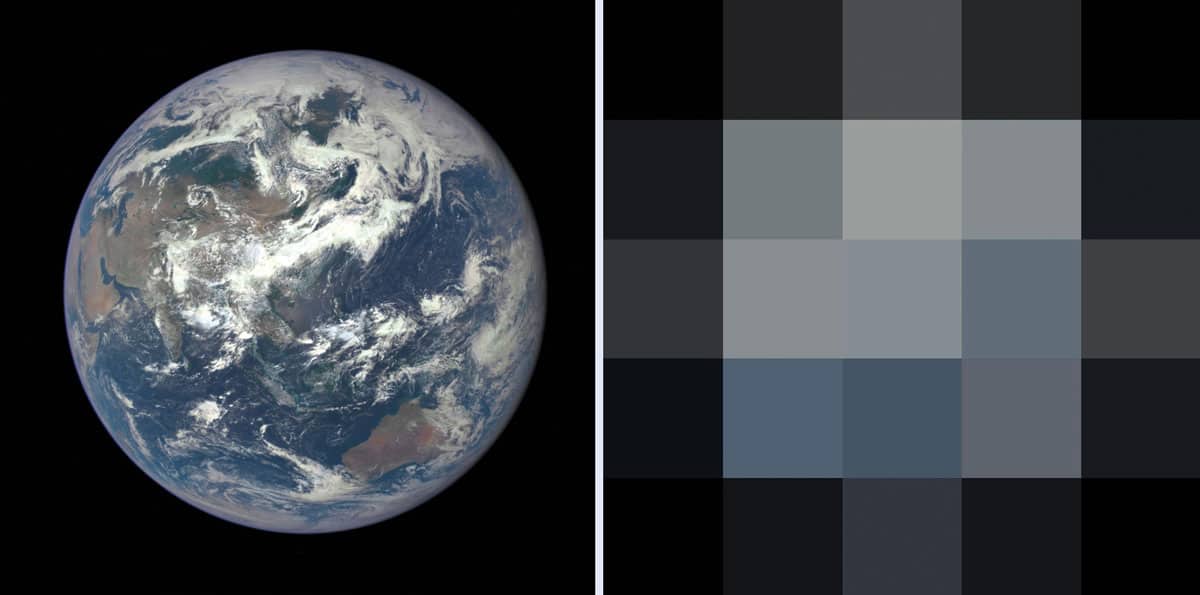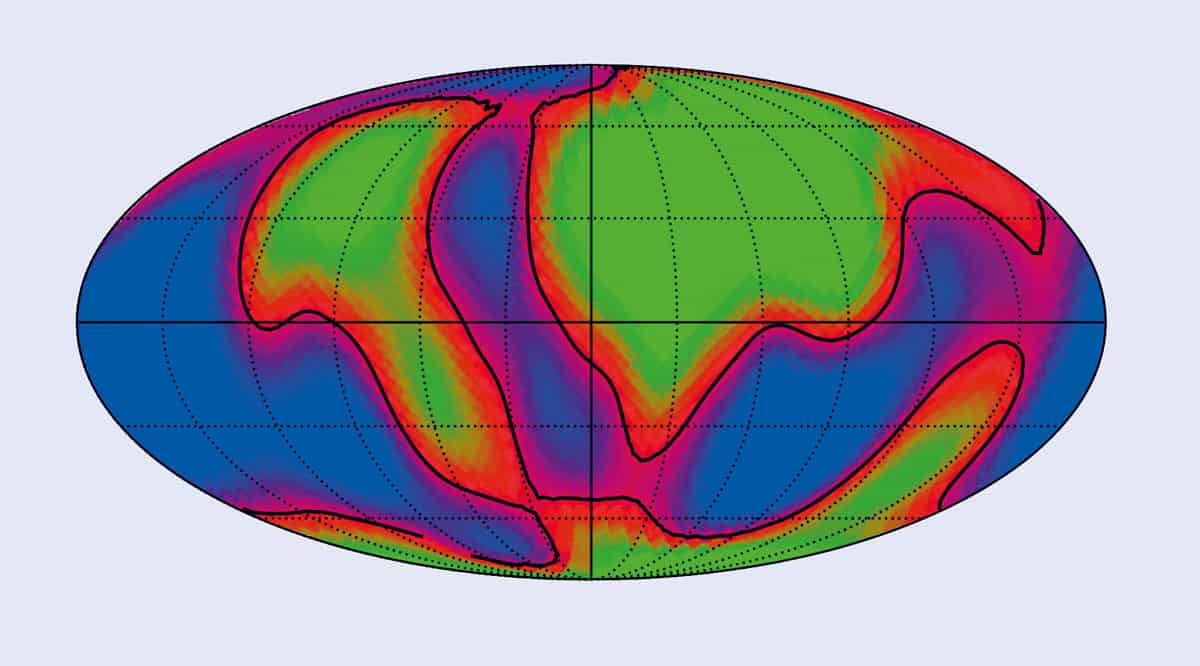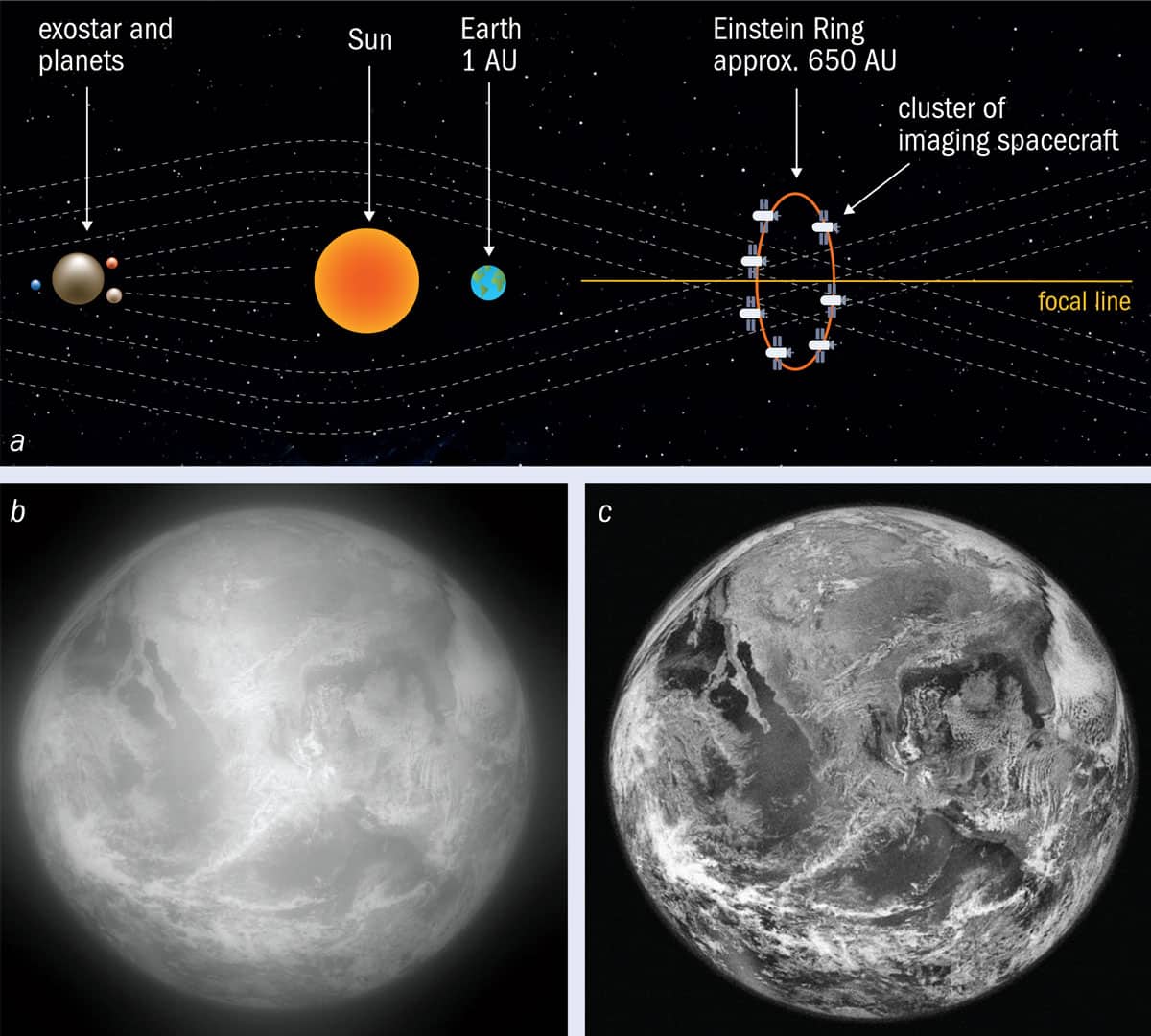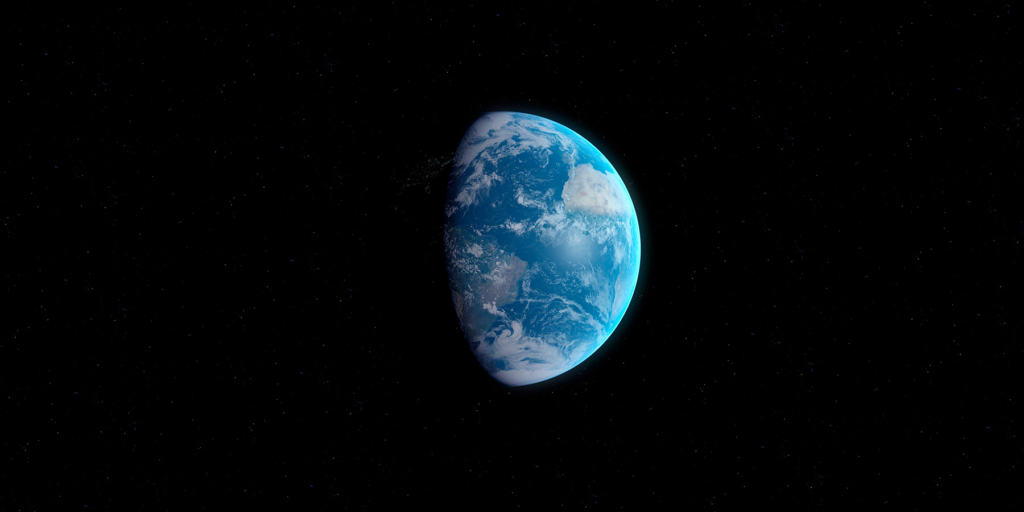Aliens spying on us from across interstellar space is a classic trope of science fiction. But working out what those extraterrestrials might see if they pointed their telescopes at us could help in our quest for finding life on distant Earth-like planets, as James Romero explains
“No-one would have believed in the last years of the 19th century that this world was being watched keenly and closely by intelligences greater than man’s.”
So begins H G Wells’ classic 1897 novel The War of the Worlds, in which terrifying Martians invade our planet. Although the creatures die after being exposed to pathogens to which they have no defence, the notion of aliens eyeing the Earth is a common plot in science fiction. In Childhood’s End, for example, Arthur C Clarke describes extraterrestrials who had secretly watched Earth’s evolution for millions of years from across interstellar space – before invading and becoming our overlords.
In reality, it is we humans who have been looking for distant worlds. Over the past few decades, astronomers have discovered almost 5000 planets circling stars other than our own. And the nature of our interstellar voyeurism is evolving. Not just content with finding and cataloguing these alien exoplanets, we want to characterize them too. Accompanied by artists’ impressions of volcanic landscapes or storms raging above shimmering oceans, such work makes distant planets feel somehow more real.
Yet, despite major investments in new space missions – notably the James Webb Space Telescope (JWST) – exoplanet surveys targeting habitable Earth-like planets are unlikely to resolve much more than dots of light for the foreseeable future. “If I look at the next 50 years, next hundred years maybe, nobody will be able to set up a telescope that’s powerful enough to resolve surface features,” says Jonathan Jiang, an atmospheric scientist at NASA’s Jet Propulsion Laboratory in Pasadena, California, who uses Earth as a laboratory to model exoplanets.
By predicting our planet’s appearance across interstellar space, we can tease out the tell-tale signatures of habitability, biology and even technology
But how can we identify livable worlds – or even signs of life itself – from just a handful of pixels? One approach gaining traction is to become interstellar spies ourselves and determine what the Earth would look like to alien astronomers. By predicting our planet’s appearance across interstellar space, we can tease out the tell-tale signatures of habitability, biology and even technology. Armed with that information, we can then turn the tables and search for alien life among the stars.

Scanning the cosmos for signs of alien technology
New eyes on alien worlds
Two techniques will be particularly fruitful in that quest. One is transmission spectroscopy, which looks at the spectrum of starlight that has passed through an exoplanet’s atmosphere. Specific wavelengths will have been absorbed by atmospheric gases, leaving characteristic absorption lines in the spectrum. The lines form a chemical fingerprint that could be used to find “biosignatures” such as oxygen or ozone. Transmission spectra could even be used to spot “technosignatures”, such as chlorofluorocarbons and nitrogen dioxide, which would be evidence of an advanced civilization that has created industrial pollutants.
Unfortunately, astronomers have not yet been able to record transmission spectra from Earth-like exoplanets around Sun-like stars as their atmospheres are so thin. But the JWST and the European Space Agency’s PLATO mission, set for launch in 2026, should be able to take the first steps. Both missions are targetting smaller “M-dwarf” stars, which are the most common class of stars in our galaxy. These red balls of gas are orbited by many exoplanets that could harbour life – one of the most famous being the TRAPPIST-1 system of seven planets, up to four of which are thought to lie in the star’s habitable zone.
The other promising technique to study exoplanets involves directly imaging these worlds, by capturing photons that have reflected off their surface. The JWST can do this, as should NASA’s forthcoming Nancy Grace Roman Space Telescope (previously known as WFIRST), which is due for launch in the mid-2020s. Direct capture of reflected light is also on the cards with two other potential NASA missions: the Large Ultraviolet Optical Infrared Surveyor (LUVOIR) and the Habitable Exoplanet Imaging Mission (HabEx). These ambitious, high-spec telescopes and their direct-imaging potential is exciting. But entire oceans, continents, atmospheres and even biological signatures will still be boiled down to just a few blurry pixels.
Transmission spectroscopy is limited too. “Light that gets filtered through the [exoplanet] atmosphere is going to be a combination of what’s going on at basically every altitude,” says Laura Mayorga, an astronomer at Johns Hopkins University in Maryland, US. Teasing out the atmospheric conditions right down at the surface of an exoplanet, where life is most likely to exist, will therefore be tricky.
Clouds on an exoplanet will make transmission spectroscopy even harder. Being opaque, they will stop light penetrating through the planet’s atmosphere, limiting how much compositional information can be extracted. What’s more, when astronomers use transmission data to model exoplanetary atmospheres, they are hamstrung by the fact that the amount of sunlight falling on a planet rises and falls – depending on, say, the number of sunspots and solar flares. This often unpredictable level of electromagnetic radiation can hide an intriguing signal or give false positives for potential biosignatures.
Who are you looking at?
Despite these challenges, both Jiang and Mayorga believe that evidence of a potentially habitable world – or even signs of one that already harbours life – can be found among these reflected rays and filtered photons. But to ensure their exoplanetary biosignature techniques work, they first want to test them out on the Earth, which is the only world we know of that does contain life. However, we can’t simply journey to another star system trillions of kilometres away and observe our home planet from there.
Luckily, in 2015, Jiang had an idea. NASA’s Deep Space Climate Observatory (DSCOVR) had just arrived at the L1 Lagrangian point 1.5 million kilometres from Earth. Designed to monitor space weather, DSCOVR constantly faces the dayside of the Earth, taking wonderful, high-quality pictures of it (figure 1). Why not, Jiang wondered, use these images to work out what our Earth would look like to aliens?

He and his Caltech colleagues began by averaging two full years of DSCOVR data to create a time series of flickering points of light. Jiang’s team then manipulated the data, altering the proportions of oceans, landmasses and cloud cover to create thousands of fake “exoEarths”. Next, they averaged the information for each fake planet into a single pixel and fed the data to a neural network. The network, they reasoned, ought to be able to train itself on this information so that, when presented with a real single pixel from our planet, it could “reverse engineer” the information and work out what the Earth is like.
The idea worked and Jiang’s team successfully used their educated algorithms to tease out the repeating 24-hour signature of an Earth day as well as patterns specific to clouds, continents and oceans (figure 2). Jiang then turned to a more metaphysical biosignature – that of “planetary complexity”. As the Caltech astrobiologist Stuart Bartlett suggested, complex interactions between biology, geology and meteorology on inhabited planets should make them appear more complex than uninhabited worlds. Complexity, Bartlett argued, could be a universal signature of life regardless of how Earth-like it is.

Life under alien skies
To find out if that complexity can indeed be observed across interstellar space, Jiang and Bartlett used a statistical technique known as “Epsilon machine reconstruction” – algorithms designed to calculate complexity. This method let the researchers compute the statistical complexity of not only their fake exoEarths based on the DSCOVR data, but also a fake “exoJupiter” derived from data taken by NASA’s Cassini mission. They were able to show that statistical complexity is indeed an effective measure of the complexity of planetary features. As a lifeless but dynamic world with dramatic storms and 650 km/h winds, an exoJupiter would provide a stern test of Bartlett’s support for complexity as an interstellar biosignature (Astron. J. 163 27). But it was a test his idea appears to have passed: Jiang’s exoEarth came out 50% “more complex” than his exoJupiter.
The Moon to the rescue
Jiang’s work suggests a way to search for biology among the stars without having to guess its chemistry or assume that aliens must be similar to us. The only trouble is that the technique is based on data from DSCOVR, whose orbit lies between the Earth and the Sun. The craft therefore never sees our planet pass in front of the Sun, which means it cannot help with transmission spectroscopy.
Thankfully, we can rely on our old friend the Moon, which passes exactly through the Earth’s shadow during a lunar eclipse. When this happens, the Moon doesn’t totally disappear from view but reflects back to us sunlight that has passed through the Earth’s atmosphere. The “blood Moon” looks eerily red, with the light reaching us being our planet’s very own transmission spectrum.

Ground-based telescopes have recorded the Earth’s transmission spectrum at optical and near-infrared wavelengths during lunar eclipses. But in 2019 a team led by Allison Youngblood from the University of Colorado used eclipse data taken by the Hubble Space Telescope to extract Earth’s transmission spectrum at ultraviolet frequencies. Collecting light of this type could help identify habitable exoplanets as it contains a signal from ozone (O3), which is a byproduct from oxygen gas (O2). Youngblood successfully prized out the signature of Earth’s ozone from our transmission spectrum, paving the way for spotting it on exoplanets too (Astron. J. 160 100).
Our growing appetite for new views of exoplanet Earth was recently demonstrated by Mayorga’s proposed launch of a satellite to capture our planet’s passage as it passes in front of the Sun. Dubbed the Earth Transit Observer, it would lie near the JWST and help astronomers to determine how deep into an exoplanet’s atmosphere transmission spectroscopy can probe (Planet. Sci. J. 2 140). The craft could also indicate whether biosignatures leave fingerprints in the easier-to-sample upper atmosphere of distant planets. It could even determine how the strength of a biosignature signal is affected by violent eruptions on the Sun or by changes in cloud conditions on Earth. “This mission would help us set guidelines for what that instrumentation [on future exoplanet projects] needs to look like,” says Mayorga.
A camera on the Moon could help astronomers to distinguish cyclical changes on exoplanets
Another astronomer keen to collect new perspectives on our planet is Patricia Boyd from NASA’s Goddard Space Flight Center in Maryland, who has drawn up plans to install a wide-field optical camera on the surface of the Moon. Dubbed EarthShine, the instrument would measure the light from Earth and average it into a single point so that the signal can be compared with real-time data from Earth-orbiting satellites.
The big advantage of a camera on the Moon is that it would see the Earth in all its different phases – ranging from a thin crescent to a full disc – whereas DSCOVR only ever sees an entire fully illuminated planet. Its data could therefore help astronomers to distinguish similar cyclical changes on exoplanets from natural biological variations, akin to trees changing colour in autumn or algae building up or “blooming”.
Polarization: a new angle on exoplanets
Beyond direct imaging and spectroscopy, there is a third way of analysing exoplanet light. That involves studying its polarization, which changes when light reflects off a surface. Smoother surfaces (such as calm water) generally reflect light waves over a narrow range of polarizations, whilst light bouncing off rougher surfaces (such as rocks or vegetation) arrive at all different angles. One of the first groups of researchers to investigate planetary patterns in polarized light was a team led by Michael Sterzik from the European Southern Observatory in Chile, who studied light that has first been reflected off the Earth and bounces back to us from the Moon (Nature 483 64).
That work then inspired researchers from Delft University of Technology in the Netherlands to simulate how light might reflect from rocky exoplanets. Dora Klindzic, an astrophysicist at Delft, believes that ice, liquid water, snow, clouds and even entire continents could all leave detectable imprints on polarized light. Indeed, Klindzic is hatching plans for an instrument on the Moon. Known as the Lunar Observatory for Unresolved Polarimetry of the Earth (LOUPE), the credit-card-sized device would give polarimetry instruments on future exoplanet telescopes like LUVOIR a benchmark signal of Earth. LOUPE could even be fitted to orbiters, landers or rovers to continuously collect Earth-reflected light as our planet rotates, weather patterns evolve and seasons change.
Youngblood is certainly a fan. “It’s important to do experiments like LOUPE now, when the telescopes that will directly image exoplanets are still being designed,” she says. Although LOUPE would capture only linearly polarized light, a group of researchers at Leiden University in the Netherlands are targeting circularly polarized light from exoplanets too. Such data could yield more direct signatures of alien life because light reflecting off plants becomes circularly polarized due to the presence of spiral-shaped green pigments, known as chloroplasts.
“The main difficulty will be to measure these small signals from far away,” admits Willeke Mulder, a PhD student at Leiden who is helping to develop instruments for the mission. Those concerns led her team to fly a prototype instrument containing a mobile polarimeter above the Swiss Alps to see if the concept works. During the trial, the device successfully distinguished between grass fields, forests and urban areas, and even revealed photosynthetic lake organisms (Astron. Astrophys. 651 A68). Next, Mulder hopes to take the technology to the International Space Station.
A mind-bending plan
One even crazier idea in the hunt for alien life involves sending craft out into the distant reaches of the solar system, 10 times further from the Sun than Pluto. As first calculated by Albert Einstein in 1936, distant light that skirts the edge of the Sun would be bent by its gravitational field, eventually converging to a focal point about 800 million kilometres from the Sun. In 2017 three researchers at the Jet Propulsion Laboratory at Caltech – Slava Turyshev, Michael Shao and Louis Friedman – realized that if you could place imagers there, it would be the perfect spot for monitoring distant light from an exoplanet that had been bent by the Sun (figure 3).

Their project, known as the Solar Gravitational Lens (SGL), would be a massive engineering challenge. But if the facility were ever built, the results would be staggering. A one-metre-diameter telescope facing the Sun at this distance would have the same resolution as a mirror 90,000 km wide located elsewhere in the solar system. Rather than recording a single pixel of light, the SGL would see surface features just tens of kilometres across and map the make-up of the atmosphere at the same scale. Storms, mountain ranges and other features would become visible.
“If there are some irregular structures, such as the Great Wall of China, we’ll see them,” says Turyshev, who is leading a NASA-funded Caltech team to calculate the SGL’s optical properties and mission requirements (Phys. Rev. D 96 024008). To garner support for the project, Turyshev has carried out simulations of how a distant, exoplanet version of the Earth would appear if viewed by the SGL. The images would certainly reveal a biological world and perhaps even one home to technological civilizations.
Turyshev, who is 58, is aware that the SGL isn’t going to be built any time soon. “I should be able to see an image of an exoplanet by the time I’m 100,” he jokes. But perhaps, with telescopes using the Sun to focus light, and neural networks detecting life from flickering exoplanet photons, we might one day take up the mantle of the interstellar voyeurs first described all those years ago by H G Wells himself.




